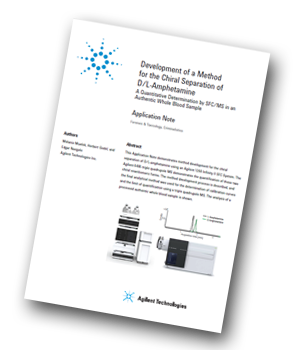This application note from Agilent Technologies shows the development of an SFC method for the chiral separation of D- and L-amphetamine and the analysis of an authentic whole blood sample.

 Summary
Summary
This application note demonstrates method development for the chiral separation of D/L-amphetamine using an Agilent 1260 Infinity II SFC System. The Agilent 6495 triple quadrupole MS demonstrates the quantification of these two chiral enantiomeric forms. The method development process is described, and
the final analytical method was used for the determination of calibration curves and the limit of quantification using a triple quadrupole MS. The analysis of a processed authentic whole blood sample is shown.
Introduction
In forensic toxicology, amphetamine can be qualitatively and quantitatively determined in bodily fluids by chromatographic methods such as GC and HPLC coupled to mass spectrometry.
This application note demonstrates the development of a fast analytical SFC/MS method for the separation of D- and L-amphetamine and its quantitative determination using a triple quadrupole mass spectrometer. This analytical method can distinguish between the quantitative amount of D-amphetamine from medical use, and the amount of D/L-amphetamine from illegal sources. Finally, this method was verified for use in forensic toxicology by the analysis of an authentic extracted whole blood sample.
Experimental
For details on instruments, instrumental set-up, software, columns, chemicals, samples and sample preparation please download the full application note.
Results and Discussion
A racemic amphetamine standard solution (100 ppb) was screened against four different chiral stationary phase columns and two organic modifiers. Because amphetamine is a basic compound, a basic additive, 0.1 % aqueous ammonia, was added to methanol and ethanol, which were used as the CO2 modifier. In the initial method development steps, different isocratic separations were carried out on all the columns.
Conclusion
This application note demonstrates the development of a method for the fast separation of the enantiomers of D/L-amphetamine using the Agilent 1260 Infinity II SFC and a highly sensitive quantitative determination using an Agilent 6495 triple quadrupole mass spectrometer. The SFC separation was possible within a total run time of 3 minutes, showing fast analysis time. The quantitative determination was performed with LOQs below 100 ppt. Finally, a reliable determination of amphetamine in a prepared whole blood sample was shown successfully.




